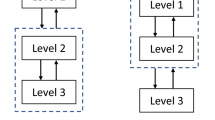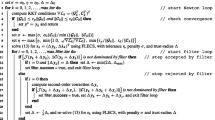Abstract
Multidisciplinary design optimization (MDO) has become essential for solving the complex engineering design problems. The most common approach is to “divide and conquer” the MDO problem, that is, to decompose the complex problem into several sub-problems and to collect the local solutions to give a new design point for the original problem. In 1990s, researchers have developed some decomposition strategies to find or synthesize the optimal model of the optimization structure in order to evenly distribute the computational workloads to multiple processors. Several MDO methods, such as Collaborative Optimization (CO) and Analytical Target Cascading (ATC), were then developed to solve the decomposed sub-problems and coordinate the coupling variables among them to find the optimal solution. However, both the synthesis of the decomposition structure and the coordination of the coupling variables require additional function evaluations, in terms of evaluating the functional dependency between each sub-problem and determining the proper weighting coefficients between each coupling functions respectively. In this paper, a new divide-and-conquer strategy, Gradient-based Transformation Method (GTM), is proposed to overcome the challenges in structure synthesis and variable coordination. The proposed method first decomposes the MDO problem into several sub-systems and distributes one constraint from the original problem to each sub-system without evaluating the dependency between each sub-system. Each sub-system is then transformed to the single-variate coordinate along the gradient direction of the constraint. The total function evaluations equal the number of constraints times the number of variables plus one in every iteration. Due to the monotonicity characteristics of the transformed sub-problems, they are efficiently solved by Monotonicity Analyses without any additional function evaluations. Two coordination principles are proposed to determine the significances of the responses based on the feasibility and activity conditions of every sub-problem and to find the new design point at the average point of the most significant responses. The coordination principles are capable of finding the optimal solution in the convex feasible space bounded by the linearized sub-system constraints without additional function evaluations. The optimization processes continue until the convergence criterion is satisfied. The numerical examples show that the proposed methodology is capable of effectively and efficiently finding the optimal solutions of MDO problems.















Similar content being viewed by others

References
Allison J (2004) Complex system optimization: a review of analytical target cascading, collaborative optimization, and other formulations. Master of Science, Mechanical Engineering, University of Michigan
Allison J, Kokkolaras M, Zawislak M, Papalambros PY (2005) On the use of analytical target cascading and collaborative optimization for complex system design. In: 6th world congress on structural and multidisciplinary optimization, Rio de Janeiro, Brazil
Balling RJ, Sobieszczanski-Sobieski J (1994a) An algorithm for solving the system-level problem in multilevel optimization. ICASE, NASA Langley Research Center, Hampton, VA: NASA-CR-195015
Balling RJ, Sobieszczanski-Sobieski J (1994b) Optimization of coupled systems: a critical overview of approaches. ICASE, NASA Langley Research Center, Hampton, VA: NASA-CR-195019
Braun RD, Moore AA, Kroo IM (1996) Use of the collaborative optimization architecture for launch vehicle design: NASA-AIAA-96-4018
Budianto IA, Olds JR (2000) A collaborative optimization approach to design and deployment of a space based infrared system constellation. In: 2000 IEEE aerospace conference, Big Sky, Montana
Chen L, Ding ZD, Li S (2005) A formal two-phase method for decomposition of complex design problems. J Mech Des 127(2):184–195. doi:10.1115/1.1778186
Cheng G, Xu L, Jiang L (2006) A sequential approximate programming strategy for reliability-based structural optimization. Comput Struct 84(21):1353–1367
DeMiguel A-V, Murray W (2000) An analysis of collaborative optimization methods. In: 8th AIAA/USAF/NASA/ISSMO symposium on multidisciplinary analysis and optimization, Long Beach, CA: AIAA-2000-4720
Dill EH (2006) Continuum mechanics: elasticity, plasticity, viscoelasticity. CRC Press
Gea HC, Oza K (2006) Two-level approximation method for reliability-based design optimisation. Int J Mater Prod Technol 25(1/2/3):99–111
Gu XY, Renaud JE, Penninger CL (2006) Implicit uncertainty propagation for robust collaborative optimization. J Mech Des 128(4):1001–1013. doi:10.1115/1.2205869
Han J, Papalambros PY (2010a) A sequential linear programming coordination algorithm for analytical target cascading. J Mech Des 132(2):021003. doi:10.1115/1.4000758
Han J, Papalambros PY (2010b) An SLP filter algorithm for probabilistic analytical target cascading. Struct Multidisc Optim 41(6):935–945. doi:10.1007/s00158-009-0450-9
Kim HM, Kokkolaras M, Louca LS, Delagrammatikas GJ, Michelena NF, Filipi ZS, Papalambros PY, Stein JL, Assanis DN (2002) Target cascading in vehicle redesign: a class VI truck study. Int J Veh Des 29(3):199–225
Kim HM, Rideout DG, Papalambros P, Stein JL (2003) Analytical target cascading in automotive vehicle design. J Mech Des 125:481–489. doi:10.1115/1.1586308
Kim HM, Chen W, Wiecek MM (2006) Lagrangian coordination for enhancing the convergence of analytical target cascading. AIAA J 44(10):2197–2207. doi:10.2514/1.15326
Kokkolaras M, Fellini R, Kim HM, Michelena NF, Papalambros PY (2002) Extension of the target cascading formulation to the design of product families. Struct Multidisc Optim 24(4):293–301. doi:10.1007/s00158-002-0240-0
Kokkolaras M, Louca LS, Delagrammatikas GJ, Michelena NF, Filipi ZS, Papalambros PY, Stein JL, Assanis DN (2004) Simulation-based optimal design of heavy trucks by model-based decomposition: an extensive analytical target cascading case study. Int J Heavy Veh Syst 11(3–4):403–433
Kreisselmeier G, Steinhauser R (1983) Application of vector performance optimization to a robust control loop design for a fighter aircraft. Int J Control 37:251–284
Kroo IM (2004) Distributed multidisciplinary design and collaborative optimization. In: VKI lecture series on optimization methods & tools for multicriteria/multidisciplinary design
Lasdon LS, Waren AD, Jain A, Ratner M (1978) Design and testing of a generalized reduced gradient code for nonlinear programming. ACM Trans Math Softw 4(1):34–50
Lassiter JB, Wiecek MM, Andrighetti KR (2005) Lagrangian coordination and analytical target cascading: solving ATC-decomposed problems with Lagrangian duality. Optim Eng 6(3):361–381
Li YJ, Lu ZS, Michalek JJ (2008a) Diagonal quadratic approximation for parallelization of analytical target cascading. J Mech Des 130(5):051402. doi:10.1115/1.2838334
Li ZJ, Kokkolaras M, Papalambros P, Hu SJ (2008b) Product and process tolerance allocation in multistation compliant assembly using analytical target cascading. J Mech Des 130(9):091701. doi:10.1115/1.2943296
Lin PT, Gea HC, Jaluria Y (2011) A modified reliability index approach for reliability-based design optimization. J Mech Des 133(4):044501. doi:10.1115/1.4003842
Michalek JJ, Papalambros PY (2005a) An efficient weighting update method to achieve acceptable consistency deviation in analytical target cascading. J Mech Des 127(2):206–214. doi:10.1115/1.1830046
Michalek JJ, Papalambros PY (2005b) Weights, norms, and notation in analytical target cascading. J Mech Des 127(3):499–501. doi:10.1115/1.1862674
Michalek JJ, Papalambros PY (2006) BB-ATC: analytical target cascading using branch and bound for mixed-integer nonlinear programming. In: Proceedings of ASME 2006 international design engineering technical conferences and computers and information in engineering conference, Philadelphia, Pennsylvania, USA: DETC2006/DAC-99040
Michelena NF, Papalambros PY (1997) A hypergraph framework for optimal model-based decomposition of design problems. Comput Optim Appl 8(2):173–196
Michelena N, Park H, Papalambros PY (2003) Convergence properties of analytical target cascading. AIAA J 41(5):897–905
Papalambros PY, Wilde DJ (2000) Principles of optimal design. Cambridge University Press, New York
Roth BD, Kroo IM (2008) Enhanced collaborative optimization: a decomposition-based method for multidisciplinary design. In: Proceedings of the ASME 2008 international design engineering technical conferences & computers and information in engineering conference, IDETC/CIE 2008, Brooklyn, New York, USA: DETC2008-50038
Schmit LA, Ramanathan RK (1973) Multilevel approach to minimum weight design including buckling constraints. AIAA J 16:97–104
Sobieszczanski-Sobieski J (1982) A linear decomposition method for large optimization problems—blueprint for development: NASA-TM-83248
Sobieszczanski-Sobieski J (1993) Two alternative ways for solving the coordination problem in multilevel optimization. Struct Optim 6:205–215
Sobieszczanski-Sobieski J, James BB, Riley MF (1985) Structural optimization by generalized, multilevel decomposition: NASA-TM-87605
Sobieszczanski-Sobieski J, Agte JS, Sandusky RR (2000) Bilevel integrated system synthesis. AIAA J 38(1):164–172
Tosserams S, Etman LFP, Papalambros PY, Rooda JE (2006) An augmented Lagrangian relaxation for analytical target cascading using the alternating direction method of multipliers. Struct Multidisc Optim 31(3):176–189. doi:10.1007/s00158-005-0579-0
Tosserams S, Kokkolaras M, Etman LFP, Rooda JE (2010) A nonhierarchical formulation of analytical target cascading. J Mech Des 132(5):051002. doi:10.1115/1.4001346
Xiao M, Gao L, Qiu HB, Shao XY, Chu XZ (2010) An approach based on enhanced collaborative optimization and kriging approximation in multidisciplinary design optimization. Adv Mat Res 118–120:399–403
Yang RJ, Gu L (2004) Experience with approximate reliability-based optimization methods. Struct Multidisc Optim 26(2):152–159
Yi P, Cheng G (2008) Further study on efficiency of sequential approximate programming for probabilistic structural design optimization. Struct Multidisc Optim 35(6):509–522
Yi P, Cheng G, Jiang L (2008) A sequential approximate programming strategy for performance-measure-based probabilistic structural design optimization. Struct Saf 30(2):91–109
Youn BD, Choi KK (2004a) An investigation of nonlinearity of reliability-based design optimization approaches. J Mech Des 126(3):403–411
Youn BD, Choi KK (2004b) Selecting probabilistic approaches for reliability-based design optimization. AIAA J 42(1):124–131
Zhao M, Cui WC (2011) On the development of bi-level integrated system collaborative optimization. Struct Multidisc Optim 43(1):73–84. doi:10.1007/S00158-010-0536-4
Author information
Authors and Affiliations
Corresponding author
Additional information
A part of this paper has been presented in Lin PT and Gea HC (2011) A gradient-based transformation method in multidisciplinary design optimization, 9th world congress on structural multidisciplinary optimization, WCSMO9, Shizuoka, Japan.
Appendix: Mathematical tools for vectors, tensors, and dot products (Dill 2006)
Appendix: Mathematical tools for vectors, tensors, and dot products (Dill 2006)
In this paper, a column vector \({\bf A} =[A_{1}, A_{2}, \ldots , A_{N}]^{T}\) can be represented as the sum of N vectors along the base vectors, as in
where e i is the ith normal basis. To avoid having to repeatedly exhibit the summation sign, the (49) is further simplified using the Einstein summation convention:
where the repetition of any index means to take the sum of all terms obtained by letting that index take on its complete range of values. Following the summation convention, a N×N tensor C is represented by
where i and j both sum from 1 to N.
The dot product of two normal bases is given by
where δ ij is the Kronecker delta. Therefore, the dot product of A and another vector B = B j e j is given as
The tensor product of the vectors A and B, different from dot product in (53), produces a tensor, as in
The tensor C operating on the vector A produces a vector, shown as follows:
The product of the tensors C and D = D ij e i e j produces a tensor, as in
Rights and permissions
About this article
Cite this article
Lin, P.T., Gea, H.C. A gradient-based transformation method in multidisciplinary design optimization. Struct Multidisc Optim 47, 715–733 (2013). https://doi.org/10.1007/s00158-012-0852-y
Received:
Revised:
Accepted:
Published:
Issue Date:
DOI: https://doi.org/10.1007/s00158-012-0852-y



